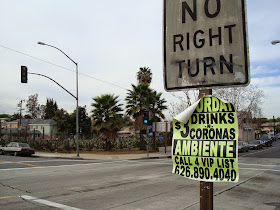This post title is borrowed from the title of a current exhibit at the Vincent Price Art Museum located on the campus of East Los Angeles College, Monterey Park, California.
 |
| Image courtesy of the Vincent Price Art Museum (VPAM) |
The genuine lives of Chinese Americans are seldom portrayed in the media. Likewise, artistic achievements by Chinese Americans in Los Angeles have not received adequate attention from art historians, including the period since the end of World War II. The
'Round the Clock exhibition is a rare, prideful opportunity to appreciate the lives of five men through their delightful artwork, as well as their productive work careers. After wandering through the large gallery hall, everything is all right: the artists are strong role models, and they remedy the media vacuum with a huge dose of positivity.
 |
| (Click on image to enlarge) |
 |
| (Click on image to enlarge) |
 |
| (Click on image to enlarge) (Above four images courtesy VPAM) |
My visit to the museum Saturday, March 10th, was enriched through the presence on the gallery floor by Milton Quon, the fifth artist exhibited.
 |
| (Click image to enlarge) Courtesy of VPAM |
Several of his children were present also, and I had ample time to speak with everyone. I asked Mr. Quon whether there were any women artists in his circle, and Helen Liu Fong came to his mind. Fong was an architect - her achievements are included in the Chinese American Museum's current exhibition
Breaking Ground: Chinese American Architects in Los Angeles (1945-1980) showcasing the work of "four pioneering Chinese American architects whose contributions were critical to the development of Los Angeles' urban and visual landscape between 1945 and 1980."
Although
'Round the Clock does not include a female artist, there is a strong consolation: Sonia Mak, guest curator, is the woman who spearheaded this exhibition to make it possible.
 |
| From left: Timothy Quon, Sherrill Quon, Milton Quon, and Sonia Mak. The watercolor drawing behind Mr. Quon was inspired by Winslow Homer. |
I learned quite a bit about Milton Quon - and I think it was mutual. He is curious and interested in everyone around him.
He had a role as an extra in Sandra Bullock's 1994 film "Speed" portraying a "Chinese" passenger on a bus. On the film set, he passed the long hours of waiting by sketching the activity going on around him.
 |
| Milton Quon explains how he first met artist Jake Lee, with son Timothy looking on. |
I did not have the notion to ask what compelled him to his subject matters. I do know that he is a native Angeleno. On exhibit includes a piece from 1990 entitled "Refinery East Los Angeles." Below is "Chavez Ravine Grocery, Effie Street" from about 1952. Was he aware of the impending doom for the Chavez Ravine neighborhood to be redeveloped for public housing or for a ball park?
 |
| (Courtesy of VPAM) |
 |
| Showcase of Tyrus Wong's commercial projects, including greeting cards. (Courtesy of VPAM) |
 |
| George Chann's "Shy Boy" (Courtesy of VPAM) |
 |
| John Kwok's abstracts (Courtesy of VPAM) |
For a critique of this exhibition, read
Blouin Art Info.
For an interesting Q & A with the curator, Sonia Mak, read the Huffington Post
issue of January 19th.
Update: Read a review on the
Los Angeles Times Culture Monster.
'Round the Clock is an admission-free exhibition - see it before it closes on May 25, 2012.

























